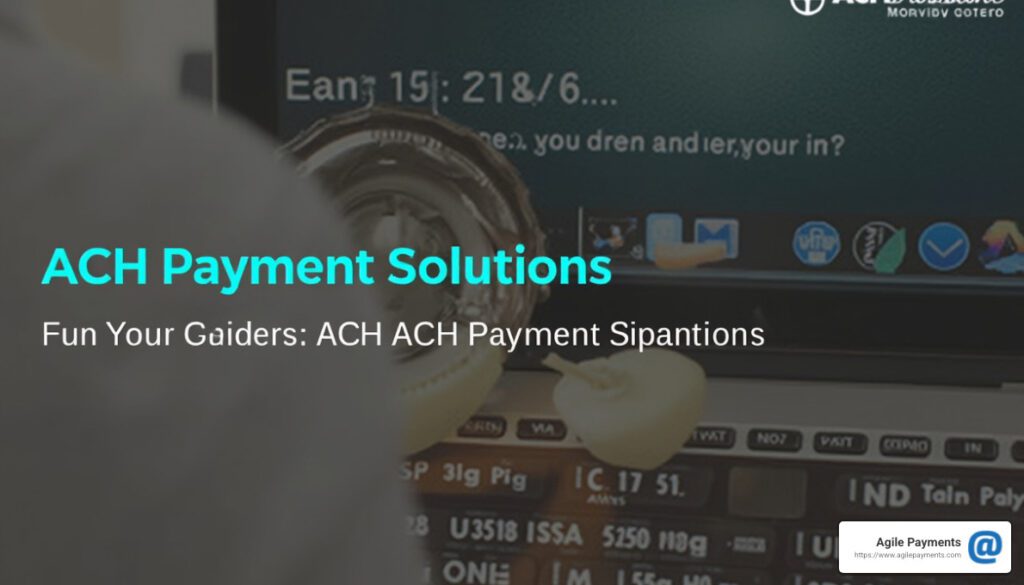ACH payment processing providers are financial services companies that facilitate the transfer of funds between bank accounts through the Automated Clearing House (ACH) Network. This network is a secure, electronic system used by banks and financial institutions across the United States for the processing of large volumes of credit and debit transactions. The ACH network provides a reliable and efficient method for businesses and individuals to accept payments without the need for cash, checks, or credit card networks.
 By utilizing ACH payment processing, entities can streamline their payment systems, allowing for cost-effective and straightforward handling of transactions such as direct deposits, payroll, bill payments, and more. The processing providers handle the complex technical and regulatory aspects of these transfers, ensuring compliance and security. As ACH transactions are batch-processed, they often prove to be an economical choice for both high- and low-volume payment needs.
The role of ACH payment processing providers is fundamental for modern business operations, given that the ACH method represents a pertinent payment option alongside traditional and emerging payment methods. Their services improve cash flow management and offer a degree of flexibility that is particularly attractive to businesses looking for effective ways to manage large volumes of payments. With technology continually evolving, these providers remain vital in adapting the ACH Network to present and future demands.
By utilizing ACH payment processing, entities can streamline their payment systems, allowing for cost-effective and straightforward handling of transactions such as direct deposits, payroll, bill payments, and more. The processing providers handle the complex technical and regulatory aspects of these transfers, ensuring compliance and security. As ACH transactions are batch-processed, they often prove to be an economical choice for both high- and low-volume payment needs.
The role of ACH payment processing providers is fundamental for modern business operations, given that the ACH method represents a pertinent payment option alongside traditional and emerging payment methods. Their services improve cash flow management and offer a degree of flexibility that is particularly attractive to businesses looking for effective ways to manage large volumes of payments. With technology continually evolving, these providers remain vital in adapting the ACH Network to present and future demands.
 ACH payment processing is an efficient and reliable method of transferring funds between bank accounts using an electronic network. It facilitates both credit and debit transactions under regulatory guidance, ensuring security and consistency in transactions.
ACH payment processing is an efficient and reliable method of transferring funds between bank accounts using an electronic network. It facilitates both credit and debit transactions under regulatory guidance, ensuring security and consistency in transactions.
 Selecting an appropriate ACH Payment Provider is crucial for businesses looking to facilitate electronic fund transfers efficiently. This entails evaluating key features, understanding pricing, ensuring ease of integration, and verifying security measures.
Selecting an appropriate ACH Payment Provider is crucial for businesses looking to facilitate electronic fund transfers efficiently. This entails evaluating key features, understanding pricing, ensuring ease of integration, and verifying security measures.
 By utilizing ACH payment processing, entities can streamline their payment systems, allowing for cost-effective and straightforward handling of transactions such as direct deposits, payroll, bill payments, and more. The processing providers handle the complex technical and regulatory aspects of these transfers, ensuring compliance and security. As ACH transactions are batch-processed, they often prove to be an economical choice for both high- and low-volume payment needs.
The role of ACH payment processing providers is fundamental for modern business operations, given that the ACH method represents a pertinent payment option alongside traditional and emerging payment methods. Their services improve cash flow management and offer a degree of flexibility that is particularly attractive to businesses looking for effective ways to manage large volumes of payments. With technology continually evolving, these providers remain vital in adapting the ACH Network to present and future demands.
By utilizing ACH payment processing, entities can streamline their payment systems, allowing for cost-effective and straightforward handling of transactions such as direct deposits, payroll, bill payments, and more. The processing providers handle the complex technical and regulatory aspects of these transfers, ensuring compliance and security. As ACH transactions are batch-processed, they often prove to be an economical choice for both high- and low-volume payment needs.
The role of ACH payment processing providers is fundamental for modern business operations, given that the ACH method represents a pertinent payment option alongside traditional and emerging payment methods. Their services improve cash flow management and offer a degree of flexibility that is particularly attractive to businesses looking for effective ways to manage large volumes of payments. With technology continually evolving, these providers remain vital in adapting the ACH Network to present and future demands.
Understanding ACH and How It Works
 ACH payment processing is an efficient and reliable method of transferring funds between bank accounts using an electronic network. It facilitates both credit and debit transactions under regulatory guidance, ensuring security and consistency in transactions.
ACH payment processing is an efficient and reliable method of transferring funds between bank accounts using an electronic network. It facilitates both credit and debit transactions under regulatory guidance, ensuring security and consistency in transactions.
The ACH Network and NACHA
The Automated Clearing House (ACH) Network is the backbone of electronic funds transfers within the United States. It is a secure system through which banks and financial institutions send and receive financial transactions. NACHA, the regulatory body governing the ACH Network, establishes the rules for ACH processing to ensure the reliability and integrity of these transactions.- Oversight by NACHA: Ensures a uniform standard of practice.
- Secure Network: Reduces the risk of fraud and errors.
Types of ACH Transactions
ACH Transactions include two primary types: ACH Credits and ACH Debits. Both serve different purposes in the financial ecosystem. ACH Credit transactions push funds into an account, beneficial for direct deposit payroll and supplier payments.- Examples: Payroll deposits, government benefits, tax refunds.
- Examples: Mortgage payments, utility bills, membership fees.
The ACH Payment Process
The process for ACH transfers involves multiple steps, with several key players including financial institutions and ACH payment processors.- Origination: Initiating party requests an ACH transaction.
- Authorization: Consent by the account holder is obtained.
- Batching: Financial institutions accumulate transactions and process them in batches.
- Clearing: The ACH operator, a central clearing facility, sorts the batched transactions and makes them available to recipient banks.
- Settlement: Funds are posted to the receiver’s Bank Account, completing the transaction.
- Originating Depository Financial Institutions (ODFIs): Submit ACH files to the ACH Network.
- Receiving Depository Financial Institutions (RDFIs): Receive ACH entries and post them to their customers’ accounts.
Choosing an ACH Payment Provider
 Selecting an appropriate ACH Payment Provider is crucial for businesses looking to facilitate electronic fund transfers efficiently. This entails evaluating key features, understanding pricing, ensuring ease of integration, and verifying security measures.
Selecting an appropriate ACH Payment Provider is crucial for businesses looking to facilitate electronic fund transfers efficiently. This entails evaluating key features, understanding pricing, ensuring ease of integration, and verifying security measures.
Key Features and Support
When examining ACH Payment Providers such as PaymentCloud, Stripe, Helcim, Dharma, Stax, and National Processing, businesses should assess the availability of essential features and the level of support offered. Providers should support various payment processing functionalities, including options for single and recurring transactions. 24/7 customer support is vital, as businesses must be able to resolve payment issues promptly.- PaymentCloud: Offers customizable payment gateways and excellent customer service.
- Stripe: Known for its extensive API that allows for a high degree of customization and automation of ACH Payments.
Pricing Structure and Fees
The cost of ACH Payment Processing varies among providers. Businesses should consider the pricing structure, including any monthly fees, processing fees, and transaction fees. For instance, Stripe and Helcim disclose their fee structures openly, providing clarity to merchants.- Helcim: No monthly fees, with competitive processing costs.
- Dharma: Transparent pricing with volume discounts for larger transactions.
Integration and Ease of Use
An ACH Payment Provider should facilitate a seamless integration process with a business’s existing systems. Providers like Stripe offer comprehensive APIs that enable simple integration with various platforms, enhancing the ease of use for merchants.- Ease of Integration: Stripe’s API is well-documented, making it user-friendly for developers.
- Merchant Account Integration: Stax provides a streamlined approach to syncing with merchant accounts.
Security and Compliance
Security is non-negotiable in payment processing. Providers must adhere to industry standards, such as PCI DSS compliance, to protect against fraud and maintain data integrity. National Processing, for example, follows stringent security protocols to safeguard ACH transactions.- PCI Compliance: An essential requirement for all the evaluated ACH Providers.
- Fraud Prevention: Payment gateways should include mechanisms for detecting and preventing fraudulent activity.




